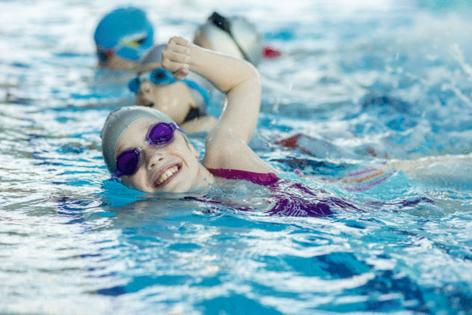Ask the Pediatrician: Why you should enroll your children in swim lessons
Published in Health & Fitness
As a pediatrician, I’ve counseled countless families about the importance of swim safety. But as a mom, I’ve lived it, from the nervous first splashes to the proud, cannonball “I did it!” moments. Learning to swim isn’t just a childhood milestone — it’s a life-saving skill, a confidence booster, and a path to lifelong health and joy.
The American Academy of Pediatrics recommends that families provide multiple layers of protection around children to help prevent drowning. One of those key layers? Teaching your child how to swim.
Learning to swim is like learning to ride a bike: a rite of passage that opens up a world of adventure. As a parent, watching your child go from clinging to the pool wall to confidently kicking across the water is nothing short of magical. And as a pediatrician, I know those lessons lay down the foundation for fitness, safety, and confidence that lasts a lifetime.
Water has an almost magnetic pull for kids. Whether they’re jumping in, splashing, or simply watching things float and sink, water fascinates them. Swim lessons are a wonderful way to safely nurture that natural curiosity and teach children how to interact with water in a respectful, enjoyable and secure way.
Each year, far too many children lose their lives to drowning. Often, it happens when a child wanders and encounters a pool or other body of water without supervision. Knowing how to swim adds a critical layer of protection. Even young children can learn basic water safety skills that could save their lives.
As a mom, that stat isn’t just clinical — it’s personal. We all want our children to explore and enjoy life. Swim lessons help make that possible safely.
Swimming is one of the best all-around activities for kids. It’s a low-impact way to build strength, endurance and coordination. It’s also a chance for them to just be kids: laughing, splashing and playing.
Swim lessons can help set the stage for a healthy lifestyle, no matter your child’s ability level. I’ve seen firsthand how the pool becomes a space where children of all shapes, sizes and backgrounds feel free and strong. And as a mom, I treasure how the pool has been a space of bonding and shared joy for my family.
“I can do it!” — those four words mean everything. In swim lessons, children learn how to break big challenges into small, achievable steps. That sense of competence builds their confidence both in and out of the water. That’s a powerful gift we can give our kids as they grow into independence.
Swimming is also incredibly beneficial for children with special health care needs. Children on the autism spectrum, for instance, are at an increased risk of drowning due to wandering. But with swim instruction, these children gain safety skills and often experience benefits like improved motor skills, reduced anxiety and even better school performance.
For children with ADHD, swimming can be a healthy outlet for energy and a way to boost focus and coordination. As a pediatrician who advocates for inclusivity, I’m passionate about helping every child access the water safely and joyfully.
The AAP recommends that all children age 1 and older should learn to swim as an important layer of protection against drowning. Other crucial layers include erecting a four-sided pool fencing at least 4 feet tall with self-closing and self-latching gates that completely isolates the pool from the house and yard, prevention of unsupervised access to the pool, and use of flotation devices whenever in or near the water.
Swim lessons don't mean they’ll be Olympic-ready toddlers, but developmentally appropriate swim lessons can teach even very young children basic water survival skills like floating, reaching the pool wall or turning to grab the edge.
Most children are ready for more formal, independent swim lessons around age 4, when their physical and cognitive development allows them to learn more advanced swim strokes and safety strategies. But earlier parent-child classes (starting as early as age 1) can help babies and toddlers get comfortable in the water, bond with their caregiver, and begin learning key skills like breath control and safe entry.
I still remember those early swim classes with my kids: the splashy songs, the cautious toe-dips, and eventually the big confident smiles. It’s more than cute; it’s potentially lifesaving.
If you're not a confident swimmer yourself, this can also be a perfect time to learn. Enrolling in adult lessons alongside your child is not only empowering, it helps model bravery and resilience. Plus, you’ll be better equipped to keep your child safe around the water.
Look for lessons through trusted organizations like the Red Cross, YMCA, local swim schools or your community recreation center. Many areas also offer low-cost or subsidized programs, so be sure to explore what is available near you.
Swim lessons aren’t just about swimming — they’re about freedom, confidence, and safety. As both a pediatrician and a mom, I wholeheartedly encourage you to find a class, pack a towel and dive in. It’s a decision you’ll never regret.
When it comes to protecting our children and giving them tools to thrive, this is one of the most joyful — and impactful — steps we can take.
____
Hailey Nelson, MD, FAAP, IBCLC, is a complex care pediatrician at Valley Children's Hospital in Madera, California. Dr. Nelson enjoys working with children of all ages and abilities and is especially passionate about providing the best possible care to medically fragile children and their families. She is also a licensed breastfeeding consultant, certified by the International Board of Lactation Consultants to support nursing mothers and their babies.
©2025 Tribune Content Agency, LLC.










Comments